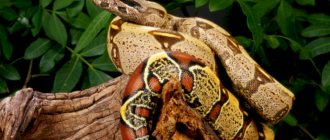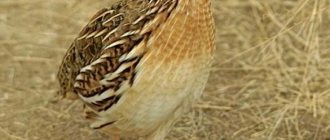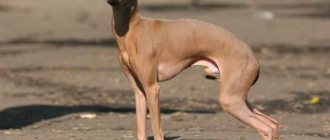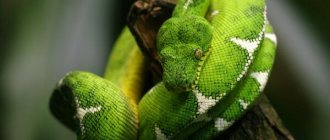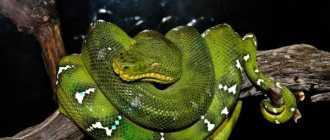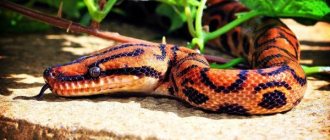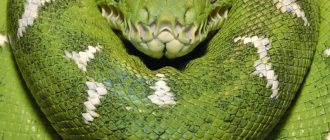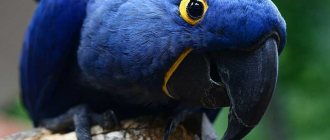Origin, appearance, habitats
This reptile belongs to the genus of true pythons. Scientists note that the snake never went through the full path of evolution - this is evidenced by the presence of two lungs and rudimentary hind limbs. The ancestors of the predator were mosasaurs and giant lizards.
In the photo of the royal python, you will immediately notice its main features. The first is a pronounced large flattened head. The second is the characteristic color. There are contrasting spots all over the snake’s body, the coloring is beautiful and memorable, however, there are morphs in which the pattern is changed, has the form of stripes or is absent altogether. The lower part of the individual is usually pale, without a pattern.
Females are usually larger than males. In its form, the python is one of the smallest - its length rarely exceeds one and a half meters.
Nutrition
Snake Head
Imperial boas hunt from ambush, sitting motionless on the forest floor and keeping a close eye on any moving objects. The protective coloration of boas brilliantly camouflages them against the background of leaf litter of the tropical forest.
As soon as a victim appears within the reach of the snake, the snake immediately grabs it with a lightning-fast throw. After being thrown, the snake immediately wraps the coils of its strong body around the victim’s body and kills it. During the killing process, blood vessels are destroyed and blood flow is stopped. When the death of the victim occurs, the snake begins to absorb it, gradually, as if pulling its body over it, moving parts of the lower jaw from side to side.
This process can take quite a long time, especially if the size of the prey is quite large. After the ingestion process is completed, the boa constrictor settles down somewhere in a secluded place (often even at a hunting site) and the digestion process begins, which can last up to a week or even more.
In their natural environment, boas feed on almost all types of vertebrates that they can swallow. Typically these are various species of rodents, small ungulates (like peccaries) and cats (for example, ocelots, jaguarundi), all types of birds of suitable size, young caimans and turtles, sloths, iguanas and other animals.
In natural habitat
There are no reliable recorded cases of attacks on humans.
When kept in a terrarium, boa constrictors can be offered all mammals and birds of suitable size. The most successful food in captivity can be considered rats, guinea pigs and rabbits, and among birds - chickens, adult hens, and quails. This species of snake has an excellent appetite. Young boas willingly consume mice of all ages, hamsters and rat pups.
After feeding, the boa constrictor needs to digest the food, for which it should be provided with a dark, quiet location and not disturbed. Despite their good appetite, snakes of this species have weak stomachs and are prone to regurgitation of food when unfavorable conditions arise.
What to feed a royal python
Keeping a royal python at home must be accompanied by proper feeding. This reptile is carnivorous. Mice, rats, quails or chickens are used as food. For pet snakes, food should be kept frozen and served only at room temperature, or even better, slightly warmed on a lamp or radiator, as they react to heat.
The feeding regimen is selected individually. It is directly affected by the age, weight of the royal python, and conditions of detention. Young animals can eat 1-2 times a week, older animals - 1 time every 1-2 weeks.
In winter and during the rutting season, the snake may refuse food for several weeks. Don't worry, because in nature the reptile behaves the same way.
It is very important not to overfeed your snake. One of the potential problems of keeping a pet at home is pet obesity.
Royal pythons have become very popular over the past few years. True, this is not surprising. Thanks to its beautiful coloring, size and character, this species has become one of the most commonly found in domestic collections, and tens of thousands of these animals are exported from Africa every year. These snakes can forgive some mistakes in keeping, and are quite suitable for beginner hobbyists.
Python regius In a terrarium, these animals need the same things they need in nature. However, it is impossible to reproduce all the conditions of the changing environment in which a wild animal finds itself in nature. Therefore, when keeping in captivity, we focus our efforts on those conditions and requirements that are absolutely necessary for the life and health of the pet.
Python regius If we take into account the huge habitat of pythons as a genus, then the same requirements for terrarium living conditions are slightly surprising. Some pythons are terrestrial, others are arboreal; some come from humid areas, others from dry areas. Moreover, most of them feel great in a terrarium under the same conditions. To be fair, the same can be said about most tropical boas.
Python regius Thus, providing the basic needs of the royal python is not difficult, but it does require several pieces of equipment.
In the terrarium
The first and most important piece of equipment needed is the terrarium itself. Its main function is to safely restrain the snake. Remember that snakes kept in a terrarium have a lot of free time, and if there is the slightest opportunity to escape, sooner or later they will take advantage of it. My own first terrariums were various cracked aquariums, the lid of which was glass, pressed down with a brick or a book. Today, however, it is possible to buy a huge number of beautiful ready-made terrariums. There is also nothing difficult about building a terrarium for a royal python with your own hands or converting a suitable household container into a terrarium.
Python regius Wood, plastic and glass - all these materials are excellent for making a terrarium. Currently, I enjoy using plastic terrariums with sliding glass on the front wall. The inside of these terrariums has a waterproof coating, which makes them easy to clean and disinfect. All edges and corners are rounded, leaving no gaps or corners that are difficult to clean. The terrariums themselves are lightweight and have good visibility. And the best part is that you don’t have to make them yourself!
Royal pythons are terrestrial animals that rarely climb branches. The area of the terrarium, based on this, is a much more important indicator than height. A baby python will be comfortable in a small container the size of a shoebox. An adult python can live its entire life in a terrarium measuring 80 by 45 cm. This is the minimum required size. Larger terrariums are welcome, but too large a size may cause feeding difficulties; Sometimes it is difficult for a snake to find food in large quantities. In addition, in large areas it is more difficult to maintain the necessary microclimate.
Python regius Despite the fact that the main purpose of the terrarium is to keep the snake from escaping, it must also create the special conditions necessary for the comfortable life of its inhabitant. Correct temperature and humidity levels are vital for reptiles. The royal python comes from drier areas than most of its fellow Pythons. However, it is important to maintain air humidity at a sufficiently high level. In nature, royal pythons spend most of their time in burrows where the air is humid. Wild snakes are not exposed to dry, hot air as their natural habitat might initially suggest. In captivity, given a choice, they will also choose a wetter place. Royal pythons, as tropical animals, need higher temperatures than those that are common in our apartments. Because of this, terrariums with animals must be additionally heated. The ideal air temperature in the terrarium is 26-27C. There are several ways to heat a terrarium. I use heat cords or heat mats. It is also possible to use incandescent lamps or ceramic heaters for these purposes. It is believed that snakes are color blind and cannot see the light of a light bulb colored red. I myself think that snakes see red, but at least they are not constantly exposed to white light, as is the case with the 24-hour use of a regular incandescent lamp in as a heater. Heating mats and ceramic heaters emit no visible light and convert electricity into heat more efficiently.
Python regius At first glance, it may seem that you need to warm up the entire terrarium, but this is not so. In the wild, snakes have the ability to choose the temperature that is optimal for them at a given time. We can provide the snake with a choice of temperature by placing the heating element in only one corner of the terrarium. The temperature will be high near the heat source, and will decrease as you move away from it. And the snake will be able to choose the temperature it currently needs. A temperature gradient of 26-32C is ideal for royal pythons. The temperature of the heat source itself may be higher, but this is not a problem as long as the specified warm and cold corner temperatures are maintained. When night falls on the earth, under natural conditions the air temperature always drops. Therefore, a slight drop in temperature at night in the terrarium is quite possible, and even desirable during the breeding season. If you use a heating element located under the bottom of the terrarium (cords, mats), then its area should not exceed 1/4-1/3 of the bottom surface. If you notice that the snake spends most of its time in one corner, then most likely the temperature regime needs to be adjusted. The temperature in the royal python cage can be controlled using a thermostat, a dimmer, or simply selecting the required heater according to the size of the terrarium.
Python regius A thermometer in a terrarium is very important in monitoring the temperature. I get a lot of calls from new breeders who are having problems with animals that don't even know what the temperature is in their snake's enclosure. Sticker thermometers, which are sold everywhere, are not suitable for measuring the air temperature in a terrarium: they, in fact, show the temperature of the wall to which they are glued, and this is not the same thing. Thermometers should be placed in areas where the snake spends most of its time. For the royal python, this is floor level. Temperatures in other places are less significant. If you don't use a thermostat, keep in mind that fluctuations in indoor temperature will cause the temperature inside the terrarium to change. The amount of heat that the heating element must produce to maintain the desired temperature in the terrarium depends on several variables. First of all, it depends on the size of the terrarium and its design, as well as its location and the size of the ventilation and any other openings. Obviously, larger terrariums require a more powerful heater, and terrariums made from wood retain heat better than plastic or glass.
Python regius The terrarium must be provided with ventilation holes, but do not forget that it is easier to maintain heat and humidity at the proper level if you reduce the size of the ventilation. The location of the ventilation holes also plays an important role. Since warm air rises, ventilation holes located at the top of the terrarium will lead to unnecessary heat loss. In this case, the heating element will work more intensely to heat the terrarium, and this, in turn, will lead to a decrease in air humidity. Ideally, small ventilation holes should be located at the ends of the terrarium. The snake should always have access to clean water. Heavy ceramic bowls that will be difficult for the python to tip over work well. If the bowl is large, the evaporation of water in it will help maintain the required level of humidity. For maximum evaporation of water, it is better to place the bowl in a warm corner.
Python regius But we must not forget that bacteria multiply quickly in warm water, so it is necessary to regularly change the water and wash the bowl. There are several terrarium substrates that are perfect for royal python terrariums. I myself use newspaper because it is a cheap adsorbent, relatively sterile and easily available. Some shredded wood substrates (mulches and chips) have a more balanced combination of utility and aesthetics than newspaper. Aspen and pine-based substrates can be used, but cedar should be avoided. Cedar shavings, which are often used in rodent substrates, can be toxic to some reptiles.
Python regius Artificial turf mats and similar products can also be used as a backing for a terrarium. They are easy to clean and sterilize, and can be cut to size. Live plants in a terrarium are very beautiful, but they are difficult to grow and also make cleaning difficult.
Choosing a pet.
Ideally, the royal python should be bred in captivity. I’m not saying this because I breed them myself - this is really the best option. Buying an animal bred in captivity will not harm the natural population. Snakes born in captivity do not have the acclimatization problems that plague wild-caught specimens.
Python regius It is especially difficult for adult “savage” royal pythons. Breed pythons, as a rule, do not have parasites, scars and injuries - constant companions of those caught in the wild. They also did not have to live with exporters, importers and dealers who might not support them well.
Python regius Baby royal pythons are some of the most readily available reptiles in the trade today, and most are “farm bred.” In late May-April, baby snakes hatch from eggs laid by pregnant females caught in the wild in Ghana, Togo and Benin. These baby snakes are exported in large quantities. Despite the fact that they were conceived in nature, they were essentially born in captivity. Most are exported within a few days of hatching. If you care for them properly, they make wonderful pets. A beginner who buys his first snake will most likely get exactly this one. When choosing a royal python, make sure that the baby has good weight and muscle tone. Should not appear dehydrated or have any remnants of previous shedding. If possible, obtain confirmation that the snake is feeding on its own. Royal pythons are highly undervalued in the reptile market and, as a result, do not always receive the care and attention they deserve. If it is not possible to adopt a snake that has been well cared for, you should try to adopt one that was recently imported.
Dinner time
Adult royal pythons caught in the wild usually have difficulty acclimatizing in captivity. They often refuse to eat for long periods. Royal pythons are long-lived. The record for living in captivity for them is 50 years. Therefore, some of the adult animals caught in the wild may well be very old. And getting used to new conditions can be very long and difficult for such animals. Using your imagination, it's not hard to imagine the shock of a wild snake finding itself in a Cincinnati bedroom aquarium.
Python regius Almost every one of these stubborn snakes starts eating sooner or later. To help your snake acclimate, there are a few things you need to do. First, make sure that the temperature and humidity in the terrarium are within the optimal range. In addition, it is necessary to provide the snake with a place where it can hide. Remember that these snakes naturally live in burrows, so the ideal hiding place should have a small opening, be dark, and allow the snake to feel securely hidden. This simple condition will reduce stress in their lives as much as possible. The shelter should be tight enough so that the snake can feel the walls while inside. You need to understand that in the wild, snakes can rarely be found on open surfaces, where they are easily accessible to predators. And according to the snake’s understanding, you are a predator! Do not touch the snake until it begins to feed regularly on its own. Attempts at domestication will only increase stress and prolong the adaptation period. If your snake refuses to eat mice, try offering rats. If rat doesn't work, try giving gerbil - many stubborn hungry people are tempted by this food. Remember that although a snake in nature eats rodents, our rats and mice are completely different species and may seem completely unfamiliar to it. Many captive snakes can learn to eat dead food, but this is very rare in the wild. You will have a much better chance of success when feeding live animals. Try to feed your snake weekly, more frequent attempts will only get in the way. Be patient. Some snakes can fast for a year or more.
Python regius Baby royal pythons may start feeding on teenage mice. Newly hatched baby snakes are small, and many new snake keepers feel that a smaller meal would be more appropriate. Although some pythons will eat mouse pebbles, a larger, more active mouse will more quickly trigger feeding behavior in a snake that has never eaten before. Growing pythons can be given larger mice, two mice, small rats and eventually adult rats. I have one large royal python that sometimes gets baby rabbits. Never leave a live food rodent unattended in a terrarium. If the snake refuses to eat it, it may seriously bite it. Feed your snake once a week or so. I keep a record of snake activity, noting dates of feeding, molting and rutting. Such recordings can be used to better understand snake behavior depending on the time of year.
Python regius Some royal pythons, especially if they are not bred animals, will fast from time to time, even if they have previously been feeding regularly. This is usually not a cause for concern. Just make sure the conditions are optimal and continue to offer food weekly. And don't lose patience. Most of the pythons will start feeding again after some time.
Basics about breeding
Most captive-bred royal pythons breed readily. Sexual behavior can be stimulated by lowering night temperatures to 21C in autumn. After such a temperature drop, partners often begin to show interest in each other.
Python regius Mating occurs over several weeks. Females develop follicles, ovulate and lay eggs over the next three or four months. Clutch sizes vary from three to twelve eggs, usually seven. The eggs can be incubated by the female herself, but an incubator can be used for this purpose. At a temperature of 32C, the eggs hatch into baby snakes after 55 days. The coloring and pattern of wild-caught royal pythons are almost identical, although there are exceptions. Some of these exceptions turned out to be hereditary. Currently, these unusual color traits are genetically fixed and available for purchase. Many of the morphs are scarce and have a high price. Most morphs are bred from one, sometimes two, unusually colored snakes caught in the wild.
Python regius Since royal pythons have few offspring and breed only once a year, it takes a long time to breed and make a new morph available. Some interesting morphs can be found on sale, and new ones, although not often, continue to appear. The royal python, due to its attractiveness, availability and low price, has become one of the most popular reptiles kept as a pet. They have a calm disposition, are unpretentious and live well in captivity. In fact, I have kept king pythons for about 30 years and they are still one of my favorite snakes. Author: Bob Clark Translation: Elena
Character and lifestyle
The reptile loves to swim and moves quickly in the water. On land, it is not so agile, although it can crawl through trees, climb into hollows and nests created by other animals. It leads a predominantly terrestrial lifestyle.
Pythons are loners. They can form a pair only for a short period for procreation during the mating season. The resident of the terrarium becomes active at night and sleeps more often during the day.
The snake tolerates being close to humans very well. She does not attack children, does not bite, unless she believes that you pose a mortal danger.
Features of a terrarium for a royal python
The conditions for keeping the royal python should be as close to natural as possible. There are several important tips for arranging a terrarium:
- The place should be spacious. It is best if it is horizontal. The optimal size of a terrarium for an adult is 90x45x45 cm. For a male, you can take a smaller terrarium - 60x4 5x45 cm. You can buy a large terrarium at once, since reptiles grow quite quickly. There is no point in buying a small one only for the first six months.
- The terrarium should be ventilated and have secure doors to prevent your pet from running away; royal pythons are very curious.
- A wood substrate, such as Rain Forest or Forest Bark, is poured onto the bottom. You should not use coconut substrate or shavings, as it is intended for high humidity, which the python does not need, and in a dry state it generates a lot of dust, clogging the snake’s respiratory tract.
- It is important that the terrarium has 1-2 shelters: in the warm and cold corners. This way the python will be able to choose a temperature that is comfortable for it.
- Be sure to organize a small pool of water from which the reptile could drink. It must be sustainable.
- Avoid excess moisture. Increase humidity while your pet is shedding.
Reproduction
All individuals who have reached approximately three to five years of age participate in reproduction, and females mature later than males. Seasonality generally does not matter, but most often these snakes breed in the dry season. As soon as the males begin the rut, they en masse go in search of females, while during this entire period they do not feed, starve, and their attention is entirely devoted to procreation.
Newborn snakes
In search of females, males often travel considerable distances. There is fierce competition among males and there are frequent manifestations of mutual aggression in the struggle for a representative of the opposite sex. Mating is preceded by a peculiar sexual behavior - the so-called “snake dances”, which end with mating. The mating process itself can last up to a day. During the entire breeding period, the female is able to mate with several males in turn.
Like the vast majority of constrictors, imperial boas are ovoviviparous snakes. In one litter there are up to thirty fully formed and independent cubs, immediately after the birth. The length of newly born individuals is no more than 50 centimeters, sometimes more.
Boa constrictor on a tree
Immediately after birth, young boas crawl into secluded places, hiding in various types of shelters. After undergoing the first moult, boa constrictors begin to actively feed, destroying any vertebrates of suitable size in their path. Usually the first victims of baby snakes are small frogs, lizards and mice.
Active growth of young boas continues until about a year, and after that it slows down sharply and proceeds more gradually. By the first year of life, boas already reach up to one meter in length and are quite capable of fending for themselves.
Royal python at the Panteric pet store
Our company supplies baby and adult royal pythons. Our pythons have been bred in captivity for several generations. We will help you choose everything you need to set up your place of detention, provide high-quality food, and answer all questions about care, hygiene, organization of reproduction, and treatment.
You can also watch an informative video about the royal python prepared by our specialists and photographs. Call, write or come to us in person.
